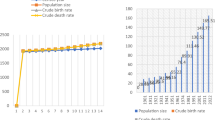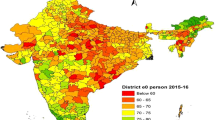Abstract
Projections of total population have been evaluated extensively, but few studies have investigated the performance of projections by age. Of those that did, most focused on projections for countries or other large areas. In this article, we evaluate projections by age for Florida and its counties, as produced and published between 1996 and 2010 by the Bureau of Economic and Business Research at the University of Florida. We first compare the precision and bias of projections of total population with the precision and bias of projections by age, at both the state and county levels. This is followed by a more detailed examination of county-level projection errors for individual age groups, first in the aggregate and then disaggregated by sex and population size. The second part of the analysis focuses on a number of adjustments that were implemented in projections published in 2006 and 2009. Intended to improve accuracy, these adjustments involved updates to the base population, fertility rates, and survival rates. We compare the accuracy of projections incorporating these adjustments with the accuracy of projections excluding them. We believe this study offers a unique opportunity to examine a variety of characteristics regarding the forecast accuracy of small-area population projections by age.






Similar content being viewed by others
References
Bloom, D. E., Canning, D., Fink, G., & Finlay, J. E. (2007). Does age structure forecast economic growth? International Journal of Forecasting, 23, 569–585.
Blumstein, A., Cohen, J., & Miller, H. D. (1980). Demographically disaggregated projections of prison populations. Journal of Criminal Justice, 8, 1–26.
Bongaarts, J., & Bulatao, R. A. (Eds.). (2000). Beyond six billion. Washington, DC: National Academy Press.
Carey, K. D. (2011). School district master planning: A practical guide to demographics and facilities planning. Lanham, MD: Rowman & Littlefield Education.
Chung, R. Y., Tin, K. Y. K., Cowling, B. J., Chan, K. P., Chan, W. M., Lo, S. V., et al. (2009). Long-term care cost drivers and expenditure projection to 2036 in Hong Kong. BMC Health Services Research, 2009(9), 172.
Costa-Font, J., Wittenberg, R., Patxot, C., Comas-Herrera, A., Gori, C., di Maio, A., et al. (2008). Projecting long-term care expenditure in four European Union member states: The influence of demographic scenarios. Social Indicator Research, 86, 303–321.
de la Croix, D., Lindh, T., & Malmberg, B. (2009). Demographic change and economic growth in Sweden: 1750–2050. Journal of Macroeconomics, 31, 132–148.
Fullerton, H. N, Jr. (2003). Evaluating the BLS labor force projections to 2000. Monthly Labor Review, 126(10), 3–12.
Greinacher, A., Fendrich, K., Brzenska, R., Kiefel, V., & Hoffmann, W. (2011). Implications of demographics on future blood supply: A population-based cross-sectional study. Transfusion, 51, 702–709.
Guralnik, J. M., Yanagishita, M., & Schneider, E. L. (1988). Projecting the older population of the United States: Lessons from the past and prospects for the future. The Milbank Quarterly, 66(2), 283–308.
Hamilton, C. H., & Perry, J. (1962). A short method for projecting population by age from one decennial census to another. Social Forces, 41(2), 163–170.
Hansen, H. S. (2010). Small-area population projections—A key element in knowledge based e-governance. In K. N. Andersen, E. Francesconi, Å. Grönlund, & T. M. van Engers (Eds.), Electronic government and the information systems perspective. Lecture notes in computer science (Vol. 6267, pp. 32–46). Berlin: Springer.
Harding, A., Vidyattama, Y., & Tanton, R. (2011). Demographic change and the needs-based planning of government services: Projecting small area populations using spatial microsimulation. Journal of Population Research, 28, 203–224.
Isserman, A. M. (1977). The accuracy of population projections for subcounty areas. Journal of the American Institute of Planners, 43(3), 247–259.
Jiang, Q., & Sánchez Barricarte, J. J. (2011). A crime rate forecast and decomposition method. International Journal of Criminology and Sociological Theory, 4(2), 648–656.
Keilman, N. (1990). Uncertainty in national population forecasting. Amsterdam: Swets and Zeitlinger.
Keilman, N. (1997). Ex-post errors in official population forecasts in industrialized countries. Journal of Official Statistics, 13(3), 245–277.
Keilman, N. (2007). UK national population projections in perspective: How successful compared to those in other European countries? Population Trends, 129, 20–30.
Keilman, N., & Kucera, T. (1991). The impact of forecasting methodology on the accuracy of national population forecasts: Evidence from the Netherlands and Czechoslovakia. Journal of Forecasting, 10(4), 371–398.
Keyfitz, N. (1981). The limits of population forecasting. Population and Development Review, 7, 579–593.
Khan, H. T. A., & Lutz, W. (2008). How well did past UN population projections anticipate demographic trends in six south-east Asian countries? Asian Population Studies, 4(1), 77–95.
Kluge, F. A. (2012). The fiscal impact of population aging in Germany. Public Finance Review, 41(1), 37–63.
Kronenberg, T., & Moeller-Uehlken, K. (2008). Demographic change as a challenge for regional infrastructure planning. Paper presented at the 48th Congress of the European Regional Science Association, Liverpool, UK.
Lee, R., Tuljapurkar, S., & Edwards, R. D. (2010). Uncertain demographic futures and government budgets in the US. In S. Tuljapurkar, et al. (Eds.), Ageing in advanced industrial states: Riding the age waves. International studies in population 8 (Vol. 3, pp. 79–100). Netherlands: Springer. doi:10.1007/978-90-481-3553-0_4.
Nowatzki, J., Moller, B., & Demers, A. (2011). Projection of future cancer incidence and new cancer cases in Manitoba, 2006–2025. Chronic Diseases in Canada, 31(2), 71–78.
Rayer, S. (2007). Population forecast accuracy: Does the choice of summary measure of error matter? Population Research and Policy Review, 26, 163–184.
Rayer, S. (2008). Population forecast errors: A primer for planners. Journal of Planning Education and Research, 27, 417–430.
Schofield, D. J., & Earnest, A. (2006). Demographic change and the future demand for public hospital care in Australia, 2005–2050. Australian Health Review, 30(4), 507–515.
Shaw, C. (2007). Fifty years of United Kingdom national population projections: How accurate have they been? Population Trends, 128, 8–23.
Smith, S. K., & Rayer, S. (2004). Population projections by age, sex, race, and Hispanic origin for Florida and its counties, 2003–2030. Florida Population Studies, Bulletin 139. Gainesville, FL: Bureau of Economic and Business Research, University of Florida.
Smith, S. K., & Rayer, S. (2006). Population projections by age, sex, race, and Hispanic origin for Florida and its counties, 2005–2030. Florida Population Studies, Bulletin 145. Gainesville, FL: Bureau of Economic and Business Research, University of Florida.
Smith, S. K., & Rayer, S. (2009). Population projections by age, sex, race, and Hispanic origin for Florida and its counties, 2008–2030. Florida Population Studies, Bulletin 154. Gainesville, FL: Bureau of Economic and Business Research, University of Florida.
Smith, S. K., & Rayer, S. (2010). Population projections by age, sex, race, and Hispanic origin for Florida and its counties, 2009–2030. Florida Population Studies, Bulletin 157. Gainesville, FL: Bureau of Economic and Business Research, University of Florida.
Smith, S. K., & Shahidullah, M. (1995). An evaluation of population projection errors for census tracts. Journal of the American Statistical Association, 90, 64–71.
Smith, S. K., & Sincich, T. (1988). Stability over time in the distribution of population forecast errors. Demography, 25, 461–474.
Smith, S. K., & Sincich, T. (1991). An empirical analysis of the effect of length of forecast horizon on population forecast errors. Demography, 28, 261–274.
Smith, S. K., & Sincich, T. (1992). Evaluating the forecast accuracy and bias of alternative population projections for states. International Journal of Forecasting, 8(3), 495–508.
Smith, S. K., & Tayman, J. (2003). An evaluation of population projections by age. Demography, 40(4), 741–757.
Smith, S. K., Tayman, J., & Swanson, D. A. (2013). A practitioner’s guide to state and local population projections: Methodology and analysis. Dordrecht: Springer.
Statistics New Zealand. (2008). How accurate are population projections? An evaluation of Statistics New Zealand population projections, 1991–2006. Wellington: Statistics New Zealand.
Stoto, M. (1983). The accuracy of population projections. Journal of the American Statistical Association, 78, 13–20.
Swanson, D. A., Tayman, J., & Bryan, T. M. (2011). MAPE-R: A rescaled measure of accuracy for cross-sectional subnational population forecasts. Journal of Population Research, 28, 225–243.
Sweeney, S. H., & Middleton, E. J. (2005). Multiregional cohort enrolment projections: Matching methods to enrolment policies. Population Space and Place, 11, 361–379.
Tayman, J., Parrott, B., & Carter, L. (1998). The role of population size in the determination and prediction of population forecast errors: An evaluation using confidence intervals for subcounty areas. Population Research and Policy Review, 17, 1–20.
Tayman, J., Swanson, D. A., & Barr, C. F. (1999). In search of the ideal measure of accuracy for subnational demographic forecasts. Population Research and Policy Review, 18, 387–409.
Wilson, T. (2007). The forecast accuracy of Australian Bureau of Statistics national population projections. Journal of Population Research, 24(1), 91–117.
Wilson, T. (2012). Forecast accuracy and uncertainty of Australian Bureau of Statistics state and territory population projections. International Journal of Population Research, 2012, 16.
Wyatt, I. D. (2010). Evaluating the 1996–2006 employment projections. Monthly Labor Review, 133, 33–69.
Author information
Authors and Affiliations
Corresponding author
Rights and permissions
About this article
Cite this article
Rayer, S., Smith, S.K. Population Projections by Age for Florida and its Counties: Assessing Accuracy and the Impact of Adjustments. Popul Res Policy Rev 33, 747–770 (2014). https://doi.org/10.1007/s11113-014-9325-x
Received:
Accepted:
Published:
Issue Date:
DOI: https://doi.org/10.1007/s11113-014-9325-x




